Related Research Articles

The Tokugawa shogunate, also known as the Edo shogunate, was the military government of Japan during the Edo period from 1603 to 1868.
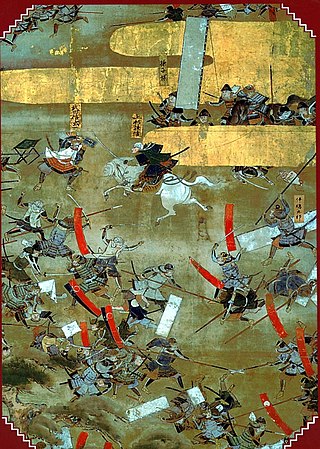
The Sengoku period is the period in Japanese history in which civil wars and social upheavals took place almost continuously in the 15th and 16th centuries. Though the Ōnin War (1467) is generally chosen as the Sengoku period's start date, there are many competing historiographies for its end date, ranging from 1568, the date of Oda Nobunaga's march on Kyoto, to the suppression of the Shimabara Rebellion in 1638, deep into what is traditionally considered the Edo period. Regardless of the dates chosen, the Sengoku period overlaps substantially with the Muromachi period (1336–1573).
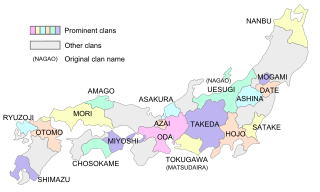
Daimyo were powerful Japanese magnates, feudal lords who, from the 10th century to the early Meiji period in the middle 19th century, ruled most of Japan from their vast, hereditary land holdings. They were subordinate to the shogun and nominally to the emperor and the kuge. In the term, dai (大) means 'large', and myō stands for myōden (名田), meaning 'private land'.

The Azuchi–Momoyama period was the final phase of the Sengoku period in Japanese history from 1568 to 1600.

Futtsu is a city located in Chiba Prefecture, Japan. As of 1 November 2020, the city had an estimated population of 42,476 in 18,115 households and a population density of 210 persons per km². The total area of the city is 205.53 square kilometres (79.36 sq mi).
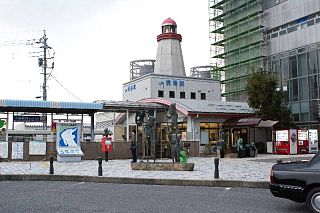
Sakaiminato is a city in Tottori Prefecture, Japan. As of 31 December 2021, the city had an estimated population of 32,012 in 13178 households and a population density of 1110 persons per km². The total area of the city is 272.06 square kilometres (105.04 sq mi).
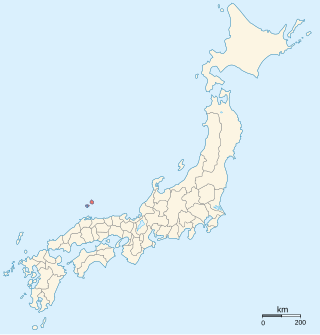
Oki Province was a province of Japan consisted of the Oki Islands in the Sea of Japan, located off the coast of the provinces of Izumo and Hōki. The area is now Oki District in modern Shimane Prefecture. Its abbreviated form name was Onshū or Inshū (隠州),

Sakai is a city located in Osaka Prefecture, Japan. It has been one of the largest and most important seaports of Japan since the medieval era. Sakai is known for its kofun, keyhole-shaped burial mounds dating from the fifth century. The kofun in Sakai include the largest grave in the world by area, Daisen Kofun. Once known for swords, Sakai is now famous for the quality of its cutlery. As of 1 January 2022, the city had an estimated population of 819,965, making it the fourteenth most populous city in Japan.

Yasuda Zenjirō was a Japanese entrepreneur from Toyama, Etchu Province who founded the Yasuda zaibatsu (安田財閥). He donated the Yasuda Auditorium to the University of Tokyo. He was a maternal great-grandfather of Yoko Ono via his adoptive son, Yasuda Zenzaburō (安田善三郎).

Sō clan were a Japanese clan claiming descent from Taira no Tomomori. The clan governed and held Tsushima Island from the 13th through the late 19th century, from the Kamakura period until the end of the Edo period and the Meiji Restoration.

The Uesugi clan is a Japanese samurai clan which was at its peak one of the most powerful during the Muromachi and Sengoku periods. At its height, the clan had three main branches: the Ōgigayatsu, Inukake, and Yamanouchi. Its most well-known member is the warlord Uesugi Kenshin (1530–1578).

This is the glossary of Japanese history including the major terms, titles and events the casual reader might find useful in understanding articles on the subject.

The Rokkaku clan was a Japanese samurai clan

Ōmura Sumitada was a Japanese daimyō lord of the Sengoku period. He achieved fame throughout the country for being the first of the daimyo to convert to Christianity following the arrival of the Jesuit missionaries in the mid-16th century. Following his baptism, he became known as "Dom Bartolomeu". Sumitada is also known as the lord who opened the port of Nagasaki to foreign trade.
Yasuda Nagahide (安田長秀) was a Japanese Military commander, who served the Uesugi clan, during the Sengoku period.

Matsusaka Castle was a Japanese castle located in the city of Matsusaka, Mie Prefecture, Japan. Throughout most of the Edo period, Matsusaka Castle was a secondary administrative center for the Kishu-Tokugawa clan, daimyō of Kishū Domain. It has been protected as a National Historic Site since 2011.
Yasuda is a Japanese surname.

Yasuda Castle was a Sengoku period flatland-style Japanese castle located in the Fuchu neighborhood of the city of Toyama, Toyama Prefecture in the Hokuriku region of Honshu, Japan. The ruins have been protected as a National Historic Site since 1981.
Arima Yoshisada was a Japanese daimyo from Hizen. He lived during the Sengoku period. He was the son and successor of Arima Haruzumi and the father of Kirishitan daimyo Arima Harunobu. He was the 12th head of the Arima clan.
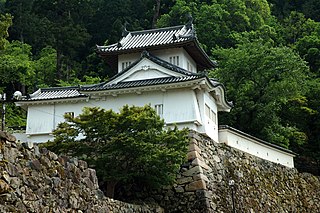
Izushi Domain was a feudal domain under the Tokugawa shogunate of Edo period Japan, located in Tajima Province in what is now the northern portion of modern-day Hyōgo Prefecture. It was centered initially around Izushi Castle in what is now the Izushi neighborhood of the city of Toyooka, Hyōgo.
References
- 1 2 Morikawa, Hidemasa. (2001). A History of Top Management in Japan: Managerial Enterprises and Family Enterprises, p. 61.
- ↑ Goldsmith, Brian. (2008). Amassing Economies: The Medieval Origins of Early Modern Japan, 1450-1700, p. 262.
- ↑ Lonien, Claude. (2003). The Japanese Economic and Social System: From a Rocky Past to an Uncertain Future, p. 44.
- ↑ Sumiya, Mikio. (2000). A History of Japanese Trade and Industry Policy, p. 157.